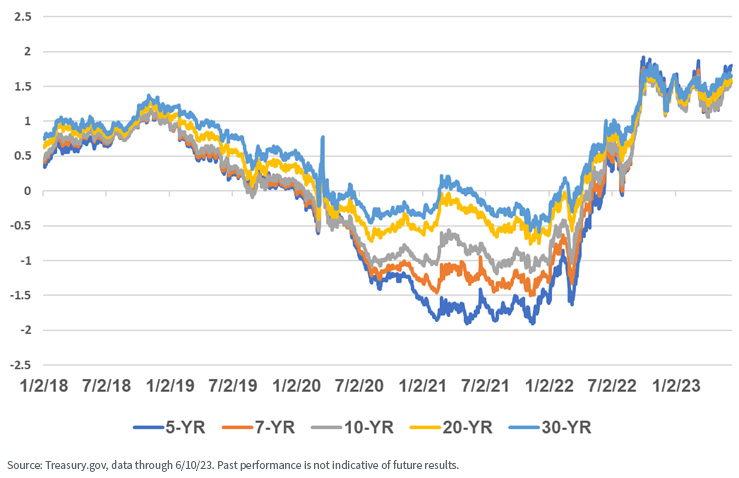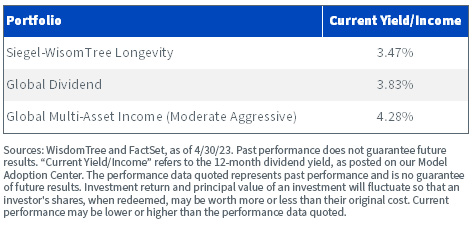By Scott Welch, CIMA ®
Chief Investment Officer – Model Portfolios
and
Kevin Flanagan
Head of Fixed Income Strategy
This article is relevant to financial professionals who are considering offering model portfolios to their clients. If you are an individual investor interested in WisdomTree ETF Model Portfolios, please inquire with your financial professional. Not all financial professionals have access to these model portfolios.
“There is income back in fixed income.”
We first began writing this periodic series of blog articles on “generating yield in an evolving market” back in March 2021 and, most recently, this past March. It’s time to check back in.
When we began this series, we were encountering the anomalous situation of equity dividend yields being higher than bond yields. It was a bleak time for bond investors—rates were near zero, and credit spreads were trading near historical lows.
My, how the “script has flipped,” both at the short end…
S&P 500 Dividend Yield – 3-Month T-Bill Yield
For definitions of terms in the graph above, please visit the glossary.
…and the long end:
Credit More Attractive than Equities
Let’s survey the current market environment. All eyes are on the Fed—it opted to “hold” in its June FOMC meeting, neither raising nor lowering rates, but the bets are leaning toward a rate hike for its July meeting. In fact, the money and bond markets have appeared to come around to the notion that rates will be higher for longer.
What we do know is that the Fed has now shifted into full “data-dependent” mode and will, more than likely, act accordingly. We also hold an experienced belief that the bond market, ultimately, will tell us the answer. We believe the result, for now, is continued bond market volatility.
 For definitions of terms in the graph above, please visit the glossary.
For definitions of terms in the graph above, please visit the glossary.
At the same time, and despite the Fed’s ongoing anxiety, inflation seems to have peaked and is moving downward, though it remains well above the Fed’s 2% “target rate.”
Treasury real yield rates have been solidly in positive territory across the maturity spectrum since June 2022, and we see no reason why they should reverse themselves and head back toward zero again. In fact, we believe they will grind higher from here, barring a deeper economic recession than we anticipate.
U.S. Treasury Yields (%)
Nominal Treasury rates have also moved higher, with the short end rising sharply in the face of the Fed’s rate hikes. The yield curve has been inverted for months (as measured by the 10-Year minus 2-Year yield and the 10-Year minus 3-Month spreads), resulting in calls of recession by many economists and advisors. Perhaps—we believe even probably—but the market continues to send “mixed messages” regarding slowing economic activity versus a still-robust labor and consumer spending environment.
Finally, credit spreads have widened from their 2021 lows, but they are well within historical levels.
So, What Is a Yield-Seeking Investor to Do?
One of our primary investment themes for 2023 is “There is income back in fixed income.” Let’s compare current nominal yields in the fixed income versus equity markets.
For definitions of terms in the table, please visit the glossary.
Certainly, in comparison to the equity markets, there is income back in fixed income.
Bankruptcies are increasing, but the overall balance sheet strength of most of corporate America remains intact. Given this, potentially generating 8+% on high-yield bonds may seem interesting for advisors seeking yield.
Product/Strategy Ideas
The inverted Treasury (UST) yield curve does not offer much of an incentive to move out in duration. While investors may wish to consider a barbell approach given the current yield backdrop, we continue to see value in tilting the allocation toward Treasury floating rate notes (FRNs).
As of this writing, UST FRNs are the highest-yielding Treasury security, and with only a one-week duration, they offer income without the volatility that potentially comes with fixed coupon issues. The WisdomTree Floating Rate Treasury Fund (USFR) is a way for investors to tap into this investment theme.
Another area to focus on for income needs is the U.S. high yield (HY) sector. Along with spreads widening over the last two years, HY levels have more than doubled over this period to levels not seen in a non-COVID-19-related environment since 2016. However, with a recession of some sort still widely expected, fears of increasing defaults have risen for HY.
An approach to consider that is selective and takes default prospects into consideration. The WisdomTree U.S. High Yield Corporate Bond Fund (WFHY) offers investors a way of screening for quality (we exclude negative cash flow companies in our Index construction) while tilting for income in the HY space.
Model Portfolio Ideas
In addition to our product lineup, WisdomTree also manages three Model Portfolios we think fit nicely into today’s yield environment, depending on investor objectives: an all-equity Global Dividend model, Multi-Asset Income models of different risk bands and the Siegel-WisdomTree Longevity model, which we manage in collaboration with our Senior Economist, Professor Jeremy Siegel.
All these models focus on seeking all or much of the current yield out of the equity allocations while using the fixed income allocation to pursue additional risk-managed yield.
Let’s look at the current yield of these portfolios (as of April 30, 2023). “Current Yield/Income” refers to the most recent 12-month dividend yield.
For the most recent standardized performance, month-end performance, and the 30-Day SEC Yield for the underlying funds, please click the respective Model Portfolio: Siegel-WisdomTree Longevity, Global Dividend, Global Multi-Asset Income (Moderate Aggressive). All yield and total return information for these model portfolios and all of the underlying securities within those models can be found in our Model Adoption Center.
Now let’s examine some hypothetical “typical” client portfolios.
Conclusions
For investors seeking yield, we believe there are multiple ways to pursue this goal without taking on excessive risk, including quality-screened high-yield (WFHY) and dividend-focused equities within the portfolio. For investors wishing not to take on duration risk while potentially benefiting from the Fed rate hiking regime, our floating rate U.S. Treasury product (USFR) may fit the bill.
Additionally, our yield-focused Model Portfolios are all delivering on their mandates of generating enhanced yield in a risk-controlled manner.
The world always continues to rotate, and for now, we have rotated back into a fixed income, yield-generating state of affairs. Investors and advisors should take advantage of it while it lasts.
Contact Us
To schedule an introductory call and learn more about how we can help you save time and money and help you achieve your client portfolio goals, fill out the form below or send us an email at [email protected].
Originally published by WisdomTree on July 7, 2023.
For more news, information, and analysis, visit the Modern Alpha Channel.
Important Risks Related to this Article
For retail investors: WisdomTree’s Model Portfolios are not intended to constitute investment advice or investment recommendations from WisdomTree. Your investment advisor may or may not implement WisdomTree’s Model Portfolios in your account. The performance of your account may differ from the performance shown for a variety of reasons, including but not limited to: your investment advisor, and not WisdomTree, is responsible for implementing trades in the account; differences in market conditions; client-imposed investment restrictions; the timing of client investments and withdrawals; fees payable; and/or other factors. WisdomTree is not responsible for determining the suitability or appropriateness of a strategy based on WisdomTree’s Model Portfolios. WisdomTree does not have investment discretion and does not place trade orders for your account. This material has been created by WisdomTree, and the information included herein has not been verified by your investment advisor and may differ from the information provided by your investment advisor. WisdomTree does not undertake to provide impartial investment advice or give advice in a fiduciary capacity. Further, WisdomTree receives revenue in the form of advisory fees for our exchange-traded Funds and management fees for our collective investment trusts.
For financial advisors: WisdomTree Model Portfolio information is designed to be used by financial advisors solely as an educational resource, along with other potential resources advisors may consider, in providing services to their end clients. WisdomTree’s Model Portfolios and related content are for information only and are not intended to provide, and should not be relied on for, tax, legal, accounting, investment or financial planning advice by WisdomTree, nor should any WisdomTree Model Portfolio information be considered or relied upon as investment advice or as a recommendation from WisdomTree, including regarding the use or suitability of any WisdomTree Model Portfolio, any particular security or any particular strategy. In providing WisdomTree Model Portfolio information, WisdomTree is not acting and has not agreed to act in an investment advisory, fiduciary or quasi-fiduciary capacity to any advisor or end client, and has no responsibility in connection therewith, and is not providing individualized investment advice to any advisor or end client, including based on or tailored to the circumstance of any advisor or end client. The Model Portfolio information is provided “as is,” without warranty of any kind, express or implied. WisdomTree is not responsible for determining the securities to be purchased, held and/or sold for any advisor or end client accounts, nor is WisdomTree responsible for determining the suitability or appropriateness of a Model Portfolio or any securities included therein for any third party, including end clients.
Jeremy Siegel serves as Senior Investment Strategy Advisor to WisdomTree, Inc., and its subsidiary, WisdomTree Asset Management, Inc. (“WTAM” or “WisdomTree”). He serves on the Model Portfolio Investment Committee for the Siegel-WisdomTree Model Portfolios of WisdomTree, which develops and rebalances WisdomTree’s Model Portfolios. In serving as an advisor to WisdomTree in such roles, Mr. Siegel is not attempting to meet the objectives of any person, does not express opinions as to the investment merits of any particular securities and is not undertaking to provide and does not provide any individualized or personalized advice attuned or tailored to the concerns of any person.
The Siegel-WisdomTree Longevity Model Portfolio seeks to address increasing longevity by shifting the focus to potential long-term growth through a higher stock allocation versus more traditional “60/40” portfolios.
WFHY: There are risks associated with investing, including the possible loss of principal. Fixed income investments are subject to interest rate risk; their value will normally decline as interest rates rise. High-yield or “junk” bonds have lower credit ratings and involve a greater risk to principal. Fixed income investments are also subject to credit risk, the risk that the issuer of a bond will fail to pay interest and principal in a timely manner or that negative perceptions of the issuer’s ability to make such payments will cause the price of that bond to decline. While the Fund attempts to limit credit and counterparty exposure, the value of an investment in the Fund may change quickly and without warning in response to issuer or counterparty defaults and changes in the credit ratings of the Fund’s portfolio investments. Please read the Fund’s prospectus for specific details regarding the Fund’s risk profile.
USFR: There are risks associated with investing, including the possible loss of principal. Securities with floating rates can be less sensitive to interest rate changes than securities with fixed interest rates but may decline in value. Fixed income securities will normally decline in value as interest rates rise. The value of an investment in the Fund may change quickly and without warning in response to issuer or counterparty defaults and changes in the credit ratings of the Fund’s portfolio investments. Due to the investment strategy of this Fund, it may make higher capital gain distributions than other ETFs. Please read the Fund’s prospectus for specific details regarding the Fund’s risk profile.


















